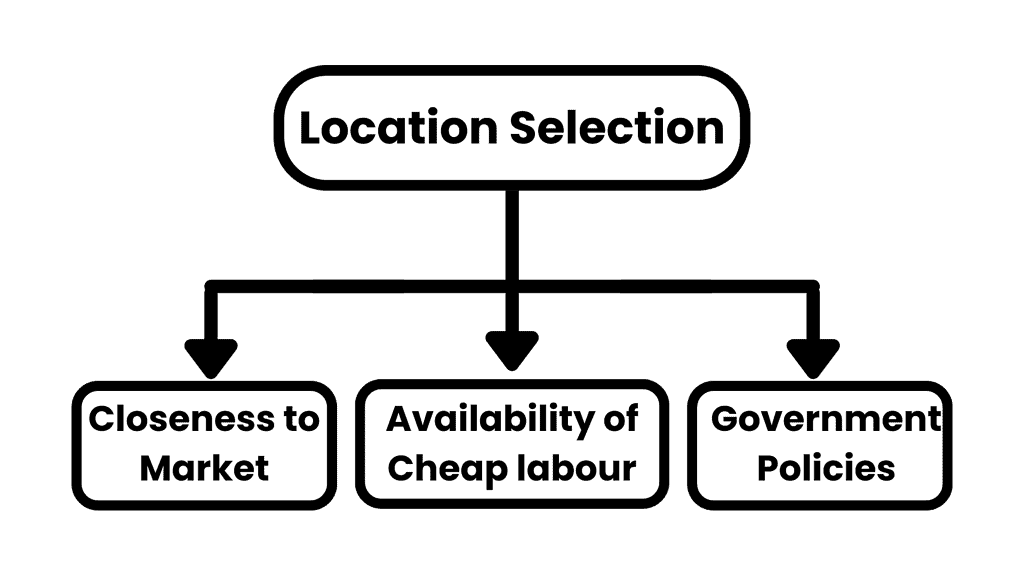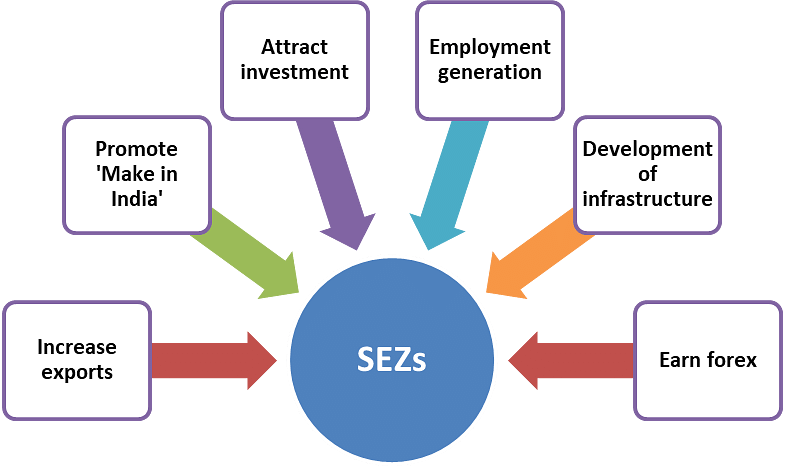Class 10 Economics Chapter 4 Notes - Globalisation and the Indian Economy
As consumers today, many of us have a diverse range of goods and services available. The latest models of digital cameras, mobile phones, and televisions from leading global manufacturers are easily accessible. Indian roads now feature a variety of car models each season, a departure from the past when Ambassador and Fiat were the dominant choices. This choice of brands extends to various products, from shirts to televisions to processed fruit juices.
 Consumer Choices
Consumer Choices
This abundance of choices is a relatively recent development in our markets, transforming rapidly within a matter of years.
The chapter explores the factors behind these changes and their impact on people's lives.
Production Across Countries
- Trade has historically been the primary means of communication between distant nations, and Multinational Corporations (MNCs) now play a crucial role in this process.
- An MNC, which oversees production in multiple countries, strategically establishes production headquarters and factories in regions with affordable labor and resources. This strategy aims to minimize production costs, enabling MNCs to maximize profits.
- MNCs choose locations close to markets where skilled and unskilled labor is available at economical rates, ensuring the availability of essential production elements.
- Additionally, MNCs may advocate for government measures that safeguard their interests in the regions where they operate.
 Factors on which location Selection Depends
Factors on which location Selection Depends
Interlinking Production Across Countries
Investment involves spending money on assets like land, buildings, machinery, and equipment. In the context of Multinational Corporations (MNCs), this investment is termed foreign investment, with the expectation of earning profits from these assets.
MNCs engage in global production through various methods of interaction with local producers:
Joint Production: MNCs often collaborate with local companies for joint production. This benefits local companies in two ways: they receive financial investments to improve production, and they gain access to advanced technology brought by the MNCs, helping them produce more efficiently.
MNC Expansion and Influence through Acquisitions: Multinational companies (MNCs) often expand by buying local companies, using their vast wealth to do so. For example, the American MNC Cargill Foods acquired the Indian company Parakh Foods, which had a strong reputation and marketing network in India. Cargill took over Parakh’s four oil refineries and became the largest producer of edible oil in India, producing 5 million pouches daily. Many MNCs have more wealth than the budgets of developing countries, giving them significant power and influence.
Controlled Production: MNCs can also control production by placing orders with small producers in industries like garments, footwear, and sports items. These small producers supply goods to MNCs, which then sell them under their own brand names. The MNCs have significant control over pricing, quality, delivery, and labor conditions for these producers, giving them substantial influence in the production process.
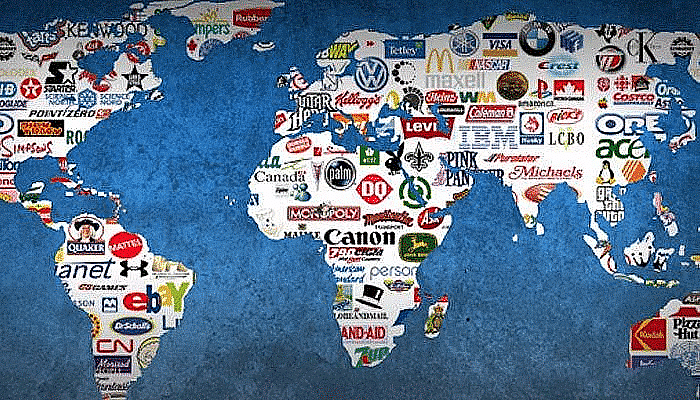 Interlinking Production Across Countries
Interlinking Production Across Countries
The collaboration between MNCs and local businesses in establishing production benefits the latter in several ways:
MNCs can provide funds for additional investments, such as acquiring new machinery to enhance production efficiency.
Multinational corporations bring advanced manufacturing technology, contributing to the modernization of local businesses.
Foreign Trade and Integration of Markets
- Foreign trade has historically connected countries through trade routes, facilitating extensive trade. Trading interests attracted companies like the East India Company to India.
- Foreign trade enables producers to extend their market presence beyond their domestic boundaries. This means they can sell their products not just in their home markets but also in global marketplaces.
- With the opening of foreign trade, goods move between markets, increasing the variety of products available. Prices of similar goods in different markets tend to become equal, and producers from different countries compete with each other despite the distance.
- Foreign trade helps connect and integrate markets across countries, promoting global competition and choice for consumers.
- The example of Chinese toys in Indian markets shows the impact of foreign trade. Chinese manufacturers saw an opportunity to export toys to India, where prices were high. With cheaper prices and new designs, Chinese toys became more popular, and within a year, 70-80% of Indian toy shops switched to selling them. This gave Indian buyers more choice at lower prices. However, while Chinese toy makers expanded their business, Indian toy makers faced losses as their sales dropped due to competition.
What is Globalisation?
The way in which the world economy is integrated with the modern world is globalisation.
The process of rapid Integration or interconnection between countries is called Globalisation
Let us see Examples
Microsoft :
- Microsoft is having its headquarters in the USA.
- This company is getting part of its software developed in India and several other countries.
- Microsoft’s software is being used across the world.
Ford Motors:
- Ford Motors based in the USA.
- Ford is having manufacturing plants in Chennai and cars manufactured in Chennai go for sale in other countries.
- Moreover, the company may be getting gearboxes produced in some other country, seat belts from a different country, and lights, and rearview mirrors from some other nation by some other company.
- Almost all the components get supplied by various vendors to the Ford motor, which assembles them to make the car.
All these activities help in generating employment opportunities across the world. This in turn affects the world economy.
You can think of various activities in the step of final production of a product or a service that take place around the world at different locations. This results in the interdependence of national economies around the world.
Factors that have Enabled Globalisation
Globalisation, the process of increasing interconnectedness and integration of economies, societies, and cultures on a global scale, has been facilitated by several key factors. These factors have played a significant role in enabling globalisation and shaping its trajectory. Here are some of the most important factors:
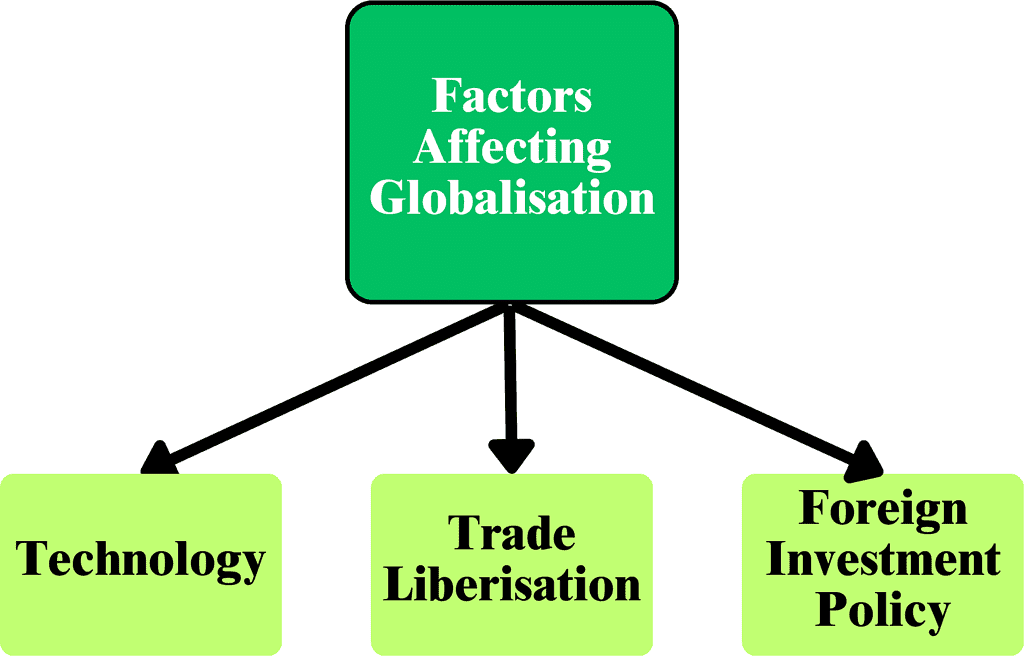 Factors Affecting Globalisation
Factors Affecting Globalisation
1. Technology:
Transportation Technology: Over the past fifty years, improvements in transportation have enabled faster and cheaper delivery of goods over long distances, facilitating international trade.
Information and Communication Technology: Significant progress in telecommunications, computers, and the Internet has transformed global communication. Technologies like telegraphs, telephones (including mobile phones), and fax have made it easier to contact people worldwide and access information instantly.
Satellite Communication: Satellite technology has further enhanced global connectivity, enabling effective communication from remote areas.
Computers and the Internet: Computers have become integral to nearly all fields, while the Internet allows instant access to information and communication. This includes sending e-mails, making voice calls, and sharing information at minimal costs.
2. Trade Liberalisation: Trade barriers imposed by governments, known as trade restrictions, can regulate or enhance international trade by deciding the types and quantities of goods to be imported. Import taxes serve as an example of a trade barrier.
Impact of Import Tax: If the Indian government imposes a tax on imported Chinese toys, the price of these toys would increase for buyers, making them less competitive compared to domestic toys. This would reduce imports and benefit Indian toy-makers.
Trade Barriers: Taxes on imports are an example of trade barriers, which are restrictions set by governments to regulate foreign trade and control the types and quantities of goods entering the country. Example: If the Indian government adds a tax on Chinese toys, these toys will become more expensive for buyers. As a result, they won’t be as attractive as Indian-made toys, leading to fewer imports of Chinese toys and helping Indian toy-makers. This tax is a type of trade barrier, which means a rule that limits how much of certain goods can come into the country.
Historical Context: After Independence, India used trade barriers to protect its emerging industries from foreign competition, allowing imports only for essential items like machinery and fertilizers.
Policy Changes in 1991: Starting in 1991, India began removing trade barriers and restrictions to encourage competition, improve domestic producer performance, and attract foreign investment.
Liberalization: The removal of trade barriers is known as liberalization. It allows businesses to make decisions about imports and exports with fewer government restrictions, promoting a more open and competitive market.
3. Foreign Investment Policy: Significant investments made by a company in a foreign enterprise are termed foreign direct investments (FDI).
- Purpose: The policy aims to attract foreign investment to boost economic growth, create jobs, and bring in new technology and expertise.
Regulation: Governments set guidelines to regulate how much and in which sectors foreign investors can invest. These regulations help protect local businesses and ensure that investments align with national interests.
Liberalization: Over time, many countries have relaxed restrictions to make it easier for foreign investors to enter the market. This process, known as liberalization, aims to promote more foreign investment by reducing bureaucratic hurdles and providing incentives.
Impact: Foreign investment can lead to economic growth by creating jobs, improving technology, and increasing competition. However, it is also essential to balance foreign investment with the protection of domestic industries and national interests.
Role of MNC in Globalisation
In the globalization process, MNCs (Multinational Corporations) play a crucial role by:
Expanding Markets: MNCs help expand markets by investing in different countries, allowing them to sell products globally.
Transfer of Technology: They bring advanced technology and management practices to new markets, improving production methods and efficiency.
Investment and Growth: MNCs invest in local companies and infrastructure, boosting economic growth and creating jobs in host countries.
Global Competition: They introduce global competition, which can lead to better quality products and lower prices for consumers.
Cultural Exchange: MNCs facilitate cultural exchange by introducing new products and practices across borders.
World Trade Organisation (WTO)
This organisation aims to liberalise international trade. This organisation says that all countries in the world should liberalise their policies.
- This organisation established the rules regarding international trade and sees that these rules are obeyed.
Currently, 161 countries are members of the WTO. India joined WTO on 1 January 1995.
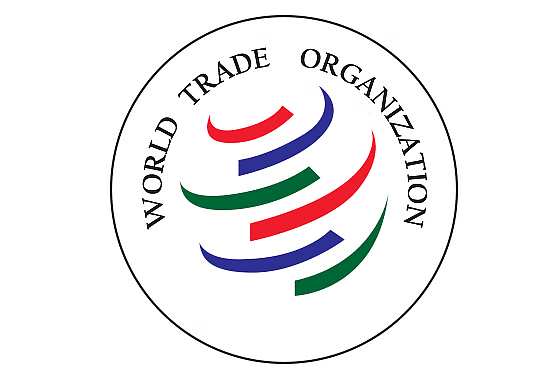 WTO Symbol
WTO Symbol
Support for Liberalization: International organizations, including the World Trade Organisation (WTO), support the removal of barriers to foreign trade and investment, advocating for free trade between countries.
WTO’s Role: The WTO, initiated by developed countries, aims to establish and enforce international trade rules. It currently has about 161member countries.
Imbalance in Trade Barriers: Despite promoting free trade, developed countries often retain their own trade barriers, while developing countries are pressured to remove theirs.
Example of Discrepancy: An example of this imbalance is the ongoing debate over trade in agricultural products, highlighting the unequal impact of WTO rules on different countries.
Impact of Globalisation in India
Globalisation has had a significant impact on India across various sectors, transforming its economy, society, and culture. Here are some of the key impacts of globalization in India:
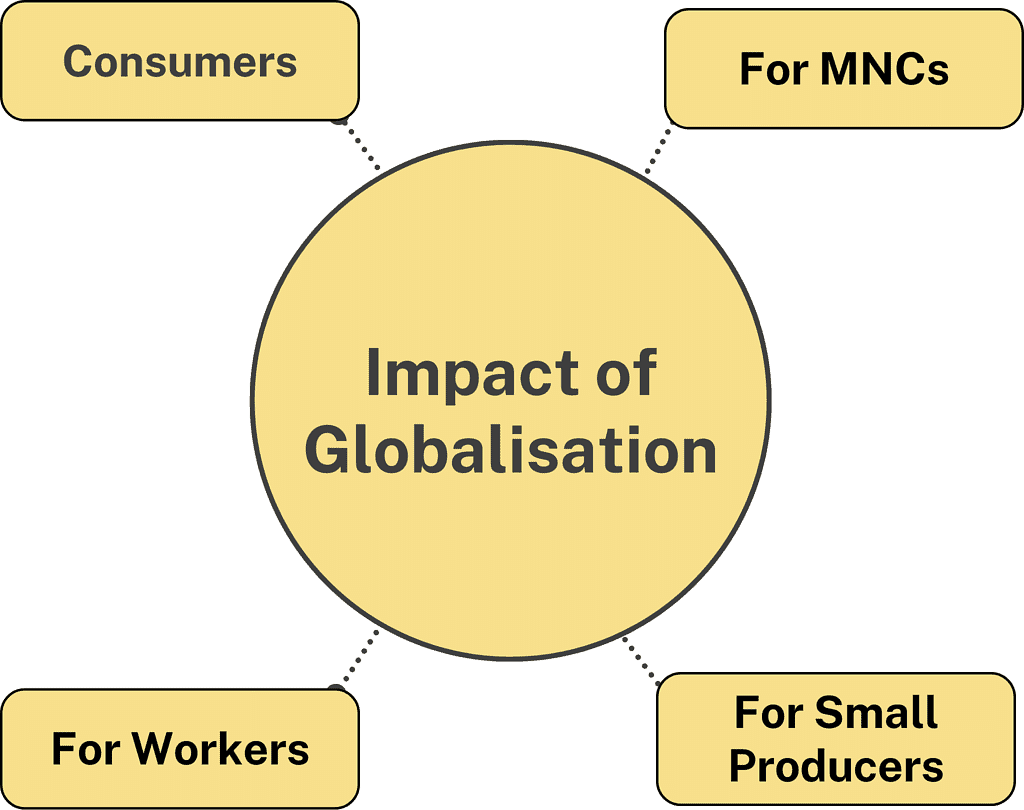 Impact of Globalisation
Impact of Globalisation
1. For Consumers
- Globalisation enabled greater competition among producers forcing them to produce a quality product at a lower price.
- Consumers today can take advantage of this competition to get a quality product at a reasonable price.
- This leads to higher standards of living.
- These products are easily available in urban areas and not in rural areas hence reach of these products is limited thus the rural people do not have the same lifestyle as urban people.
2. For MNCs
 Large MNCs order their products from Indian exporters.
Large MNCs order their products from Indian exporters.
- With globalisation, MNCs have prospered a lot.
- Large MNCs order their products from Indian exporters.
- They have increased their investment in India indicating that they are benefitting from the investment.
- Recognising the opportunities in an urban area MNCs are now interested in industries such as cell phones, automobiles, electronics, soft drinks, fast food and banking services.
- MNCs can now shift to another country to lower production costs and gain higher profits.
- But this shift creates adverse effects on the workers of the companies. They will get cheap qualified labour at low wages.
- Producers will have the choice to outsource the work from a different country where there is cheap labour and production cost.
3. For Workers
- No Job Security – With growing market competition among industries employers prefers to hire a worker as per need.
- Thus they can fire the worker at any time.
- Thus there is no job security for the workers. very long working hours – Worker has to work for long hours to meet the demands. They will have no choice but to listen to their employer.
- Low wages – Job opportunities are limited and the number of workers is far more than the opportunities. Thus producers easily get cheap labour and workers are ready to work at less wages.
4. For Small Producers
- Small producers face close competition with such well-established firms.
- They can bear small losses but small producers can not bear such losses and ultimately end up selling their companies to MNCs. Example: Batteries, capacitors, plastics, toys, tyres, dairy products and vegetable oil are some examples of industries where small manufacturers are hit hard due to competition.
- Some of the Indian multinational companies such as Tata Motors, Infosys, Ranbaxy, Asian Paints, and Sundram Fasteners benefited from globalisation as they have spread their operations worldwide.
- There are enough opportunities for skilled workers but unskilled workers remained poor.
Steps to Attract Foreign Investment
- The government of India set up Special Economic Zones to attract foreign Investors.
- SEZs are the Industrial zones where Industries get world-class facilities such as electricity, water, roads, transport, storage, recreational and educational facilities.
- Companies that are set up in SEZ areas will do not have to pay taxes for an initial period of five years.
- The government also allows these companies to ignore some of the labour laws such as instead of hiring regularly these companies are allowed to hire workers for short periods i.e. whenever required.

The Struggle for a Fair Globalisation
Unequal Benefits of Globalization: Not everyone benefits equally from globalization; those with education, skills, and wealth often gain the most, while others do not share in the benefits.
Need for Fair Globalization: To make globalization more equitable, it should create opportunities for everyone and ensure that its benefits are more widely shared.
Role of Government: Governments can play a crucial role in promoting fair globalization by:
- Protecting the interests of all citizens, not just the wealthy and powerful.
- Implementing and enforcing labor laws to ensure workers’ rights.
- Supporting small producers until they can compete effectively.
- Using trade and investment barriers if necessary.
- Negotiating for fairer rules at the WTO.
- Collaborating with other developing countries to challenge the dominance of developed nations in the WTO.
People’s Role: Public campaigns and representation by people’s organizations have influenced important trade and investment decisions at the WTO, showing that people can also contribute to making globalization fairer.
|
63 videos|445 docs|87 tests
|
FAQs on Class 10 Economics Chapter 4 Notes - Globalisation and the Indian Economy
| 1. What is globalisation and how does it affect economies? |  |
| 2. What factors have enabled globalisation in recent years? |  |
| 3. What role does the World Trade Organisation (WTO) play in globalisation? |  |
| 4. How has globalisation impacted India’s economy? |  |
| 5. What is meant by the struggle for a fair globalisation? |  |

|
Explore Courses for Class 10 exam
|

|
